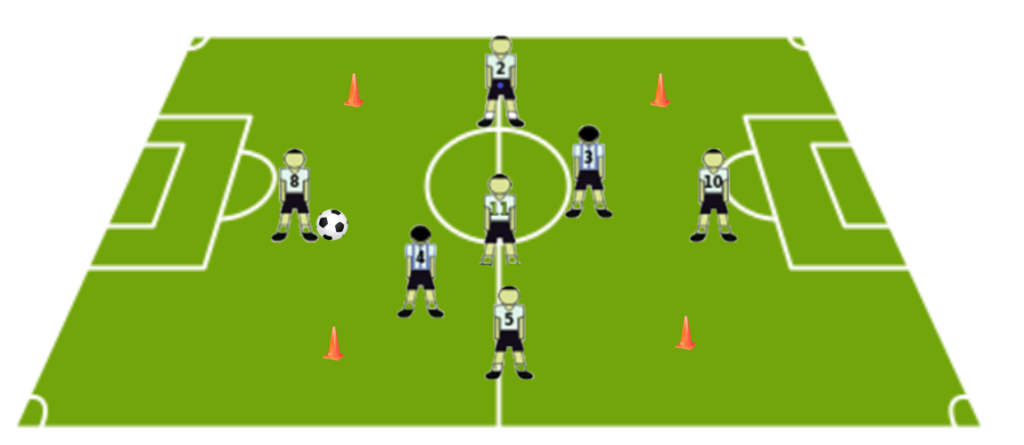5v2 rondo [Full Guide for Soccer Coaches]
Now that we have mastered the 4v1 rondo, it’s time to move to the next step. The expectation is to spend about a month on variations before moving to 5v2 rondo. Slowly moving the size from 12×12 to 8×8 steps is the path and the point when the players can do over 10 passes is when it is time to challenge them.
Why do the 5v2 rondo?
Most people think that the natural progression from 4v1 is 4v2. However, by adding the intermediate step of 5v2, we increase the pressure while not reducing the number of options. When creating a large 5v2 setup, the passer should have 2 passing options, same as at 4v1. This means that we will focus on one step only at at time, which is increasing the pressure. The next step afterwards will be to receive a passing option which is a decision making skill.
Setup

The setup is very simple – add one player from each side in the middle and make sure you start with large fields. The rules have not changed for anybody and the game variations are the same from the 4v1. If many players want to be in the middle, that is a good sign. However, initially the player in the middle will block the far pass. Therefore, it is up to you to encourage players to move and open the lanes for pass to them.
Variations of 5v2 rondo
This is the first rondo that we do with certain target of position and specialty. When we say that anything can be taught in a rondo, we really mean that. We use the rondo as a platform to teach something and because the players know the setup, we can quickly start the game even when players don’t know what the new objective is. The official goal is to increase the pressure, but let us examine some lessons we can teach.
Central midfielder rondo
The most obvious one is for the central midfielder role. One new option is to introduce the halfturn and pass to the player across. The rapid progress that we have seen in our players has been incredible. The result in our best player has been almost immediately grasping the concept of switching the ball from the left flank to the right, and vice versa. It was almost scary how effective this setup was with minimal coaching.
Wingers
If we make the field narrow, say 8 by 12, then the players on the longer sides become wingers going up and down the flanks. Moving off the ball, using backfoot and coordinating with the central midfielder will be created naturally. It is definitely not something to be done immediately, but after 3-4 practices, it is an interesting variant for your players.
Throw in
Once the players are mostly proficient in the rondo, it is a great time to introduce throw ins into the mix. The rule of defenders staying right in the middle still holds, so the receiving with one touch should always be an option. It is a great game for the players and because of the closeness of the teammates, it is very unlikely for them to do a faulty throw in.
RONDOS
No Opponents Rondo
Introduction to rondos with 3v0 and 4v0. Coaching passing, receiving, and the concept of “backfoot”.
First opponent
Introduce an opponent in the rondo. Create the need to move off the ball and think of passing lanes.
Increase intensity
Limit one passing option, and improve decision-making. Put pass-and-go into practice. Introduce a transition rondo to 5v3.
Increase complexity
Introduce team pressing of two players. Coach the central midfielder for the first time.
Pro Rondo
The rondo that pros play. Teaching to split the opponents with the right weight of the pass.
Positional play
All variations of the complex rondos before transitioning into positional play and game scenarios.

